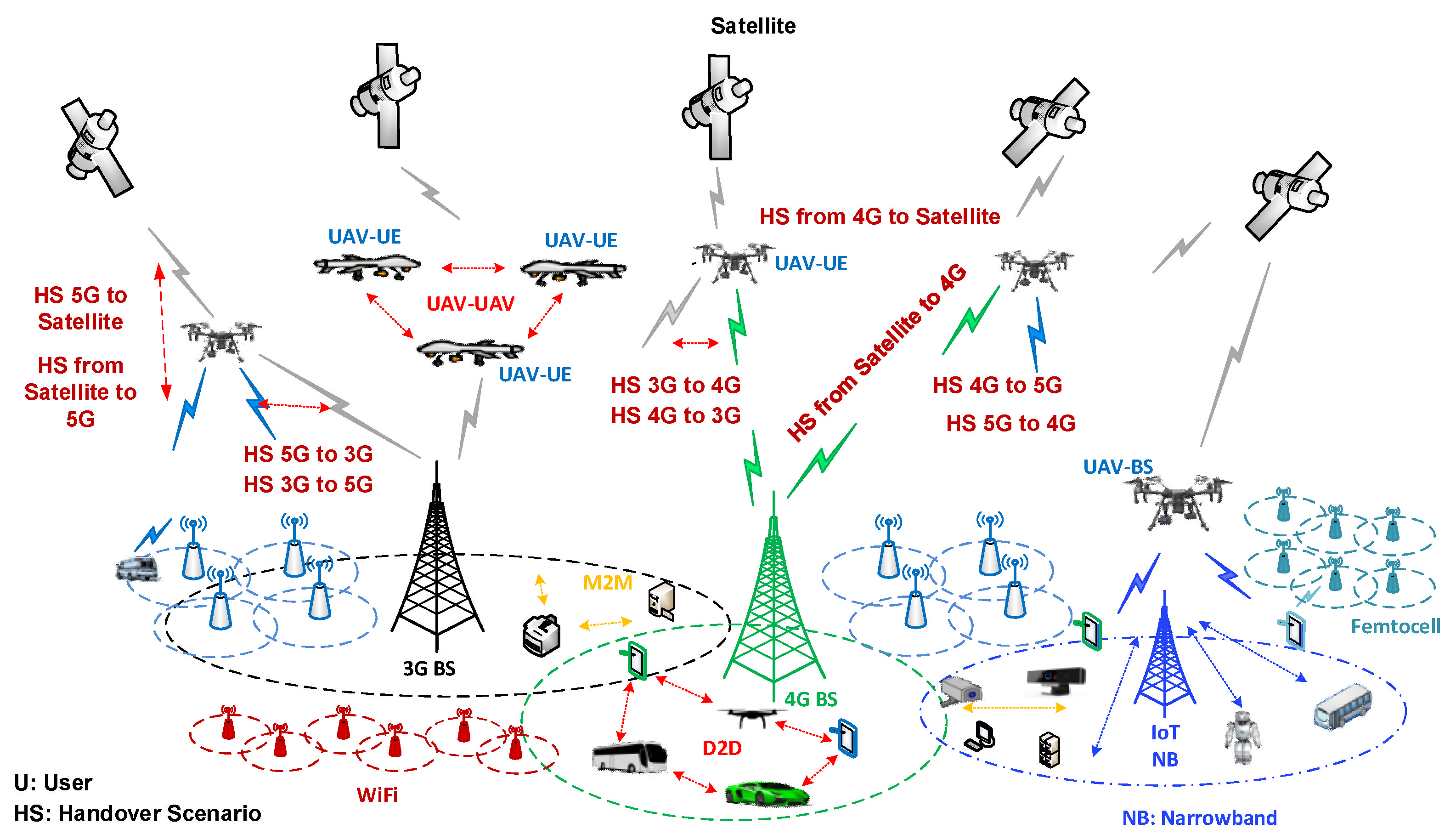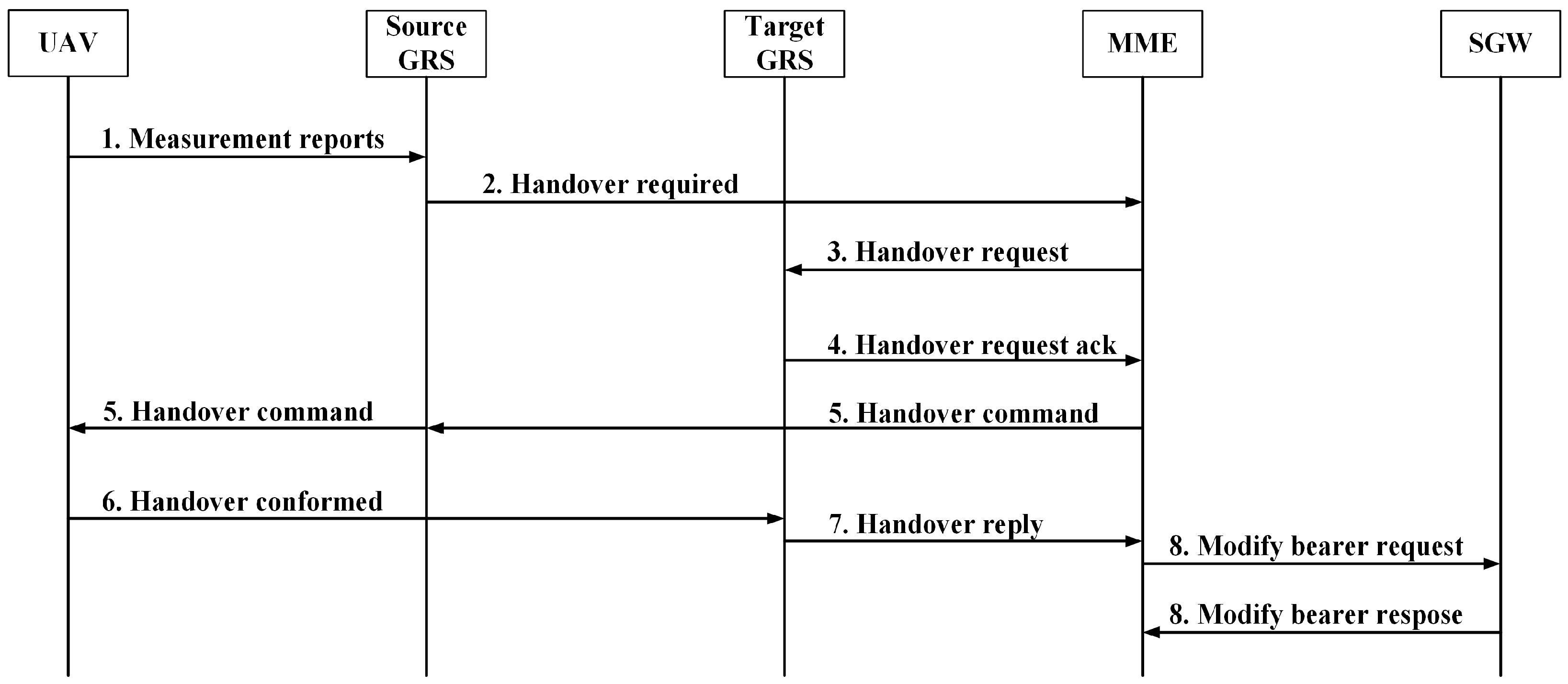The drone, also known as an Unmanned Aerial Vehicle (UAV), is an autonomously flying aircraft controlled by an individual. The terms drone and UAV are used interchangeably here. Drones have attracted extensive attention for their environmental, civil, and military applications. Because of their low cost and flexibility in deployment, drones with communication capabilities are expected to play key important roles in Fifth Generation (5G), Sixth Generation (6G) mobile networks, and beyond. 6G and 5G are intended to be a full-coverage network capable of providing ubiquitous connections for space, air, ground, and underwater applications.
- drone
- drone network
- connected drone
- Unmanned Aerial Vehicle (UAV)
- handover decision algorithm
- handover management
1. Introduction
2. Handover Management for Drone Networks
2.1. Handover in Drone Networks
2.2. Handover Decision Algorithms
2.3. Handover Types

2.4. Handover Procedure in 5G

-
The UE periodically sends the measurement report to the S-BS.
-
The S-BS configures the measurement procedure of the UE.
-
Based on the measurement report, the S-BS makes the switch decision, and the handover request is then received by the Target Base Station (T-BS).
-
The T-BS replies with an acknowledgment to the S-BS based on its resources.
-
The handover is initiated, and the T-BS supplies the UE with the necessary information, connecting it to the target cell.
-
The UE receives uplink allocation and timing info sent from the T-BS.
-
The T-BS updates the AMF for UE cell alteration, the UPF is updated by the AMF for the UE, the path of the UE is updated by the UPF, then the AMF notifies the T-BS for path update.
-
The S-BS is updated by the T-BS for the completion of the handover.
This entry is adapted from the peer-reviewed paper 10.3390/s22176424
References
- Li, X.; Savkin, A.V. Networked unmanned aerial vehicles for surveillance and monitoring: A survey. Future Internet 2021, 13, 174.
- Bajracharya, R.; Shrestha, R.; Kim, S.; Jung, H. 6G NR-U based wireless infrastructure UAV: Standardization, opportunities, challenges and future scopes. IEEE Access 2022, 10, 30536–30555.
- Zeng, Y.; Zhang, R.; Lim, T.J. Wireless communications with unmanned aerial vehicles: Opportunities and challenges. IEEE Commun. Mag. 2016, 54, 36–42.
- Akram, R.N.; Markantonakis, K.; Mayes, K.; Habachi, O.; Sauveron, D.; Steyven, A.; Chaumette, S. Security, privacy and safety evaluation of dynamic and static fleets of drones. In Proceedings of the 2017 IEEE/AIAA 36th Digital Avionics Systems Conference (DASC), St. Petersburg, FL, USA, 17–21 September 2017; IEEE: Piscataway, NJ, USA, 2017.
- Mozaffari, M.; Saad, W.; Bennis, M.; Nam, Y.-H.; Debbah, M. A tutorial on UAVs for wireless networks: Applications, chal-lenges, and open problems. IEEE Commun. Surv. Tutor. 2019, 21, 2334–2360.
- Asadpour, M.; Bergh, B.V.D.; Giustiniano, D.; Hummel, K.A.; Pollin, S.; Plattner, B. Micro aerial vehicle networks: An experimental analysis of challenges and opportunities. IEEE Commun. Mag. 2014, 52, 141–149.
- Marcus, M.J. Spectrum policy challenges of UAV/drones . IEEE Wirel. Commun. 2014, 21, 8–9.
- Elmeseiry, N.; Alshaer, N.; Ismail, T. A detailed survey and future directions of unmanned aerial vehicles (UAVs) with po-tential applications. Aerospace 2021, 8, 363.
- Jiang, X.; Sheng, M.; Zhao, N.; Xing, C.; Lu, W.; Wang, X. Green UAV communications for 6G: A survey. Chin. J. Aeronaut. 2021, 35, 19–34.
- Hayat, S.; Yanmaz, E.; Muzaffar, R. Survey on unmanned aerial vehicle networks for civil applications: A communications viewpoint. IEEE Commun. Surv. Tutor. 2016, 18, 2624–2661.
- Aggarwal, S.; Kumar, N.; Tanwar, S. Blockchain-envisioned UAV communication using 6G networks: Open issues, use cases, and future directions. IEEE Internet Things J. 2020, 8, 5416–5441.
- Muruganathan, S.D.; Lin, X.; Maattanen, H.-L.; Sedin, J.; Zou, Z.; Hapsari, W.A.; Yasukawa, S. An overview of 3GPP release-15 study on enhanced LTE support for connected drones. IEEE Commun. Stand. Mag. 2021, 5, 140–146.
- Popescu, D.; Dragana, C.; Stoican, F.; Ichim, L.; Stamatescu, G. A collaborative UAV-WSN network for monitoring large areas. Sensors 2018, 18, 4202.
- Al-Fuqaha, A.; Guizani, M.; Mohammadi, M.; Aledhari, M.; Ayyash, M. Internet of things: A survey on enabling technologies, protocols, and applications. IEEE Commun. Surv. Tutor. 2015, 17, 2347–2376.
- Park, T.; Abuzainab, N.; Saad, W. Learning How to Communicate in the Internet of Things: Finite resources and heterogeneity. IEEE Access 2016, 4, 7063–7073.
- Zanella, A.; Bui, N.; Castellani, A.; Vangelista, L.; Zorzi, M. Internet of things for smart cities. IEEE Internet Things J. 2014, 1, 22–32.
- Ferdowsi, A.; Saad, W. Deep learning-based dynamic watermarking for secure signal authentication in the internet of things. In Proceedings of the 2018 IEEE International Conference on Communications (ICC), Kansas City, MO, USA, 20–24 May 2018; IEEE: Piscataway, NJ, USA, 2018.
- Ding, G.; Wu, Q.; Zhang, L.; Lin, Y.; Tsiftsis, T.A.; Yao, Y.-D. An amateur drone surveillance system based on the cognitive internet of things. IEEE Commun. Mag. 2018, 56, 29–35.
- Rodrigues, L.; Riker, A.; Ribeiro, M.; Both, C.; Sousa, F.; Moreira, W.; Cardoso, K.; Oliveira-Jr, A. Flight planning optimization of multiple UAVs for internet of things. Sensors 2021, 21, 7735.
- Crawley, E.F. Intelligent structures for aerospace-A technology overview and assessment. AIAA J. 1994, 32, 1689–1699.
- Sundqvist, L. Cellular Controlled Drone Experiment: Evaluation of Network Requirements. Master’s Thesis, Aalto University School of Electrical Engineering, Espoo, Finland, 2015.
- Lefebure, M. Device for Piloting a Drone. U.S. Patent 8214088B2, 3 July 2012.
- Orsino, A.; Ometov, A.; Fodor, G.; Moltchanov, D.; Militano, L.; Andreev, S.; Yilmay, O.N.C.; Tirronen, T.; Torsner, J.; Araniti, G.; et al. Effects of heterogeneous mobility on D2D-and drone-assisted mission-critical MTC in 5G. IEEE Commun. Mag. 2017, 55, 79–87.
- Al-Hourani, A.; Gomez, K. Modeling cellular-to-UAV path-loss for suburban environments. IEEE Wirel. Commun. Lett. 2017, 7, 82–85.
- Van den Bergh, B.; Vermeulen, T.; Pollin, S. Analysis of harmful interference to and from aerial IEEE 802.11 systems. In Proceedings of the First Workshop on Micro Aerial Vehicle Networks, Systems, and Applications for Civilian Use, Florence, Italy, 18 May 2015.
- Gupta, L.; Jain, R.; Vaszkun, G. Survey of Important Issues in UAV Communication Networks. IEEE Commun. Surv. Tutor. 2015, 18, 1123–1152.
- Van Der Bergh, B.; Chiumento, A.; Pollin, S. LTE in the sky: Trading off propagation benefits with interference costs for aerial nodes. IEEE Commun. Mag. 2016, 54, 44–50.
- Banagar, M.; Chetlur, V.V.; Dhillon, H.S. Handover Probability in Drone Cellular Networks. IEEE Wirel. Commun. Lett. 2020, 9, 933–937.
- Amer, R.; Saad, W.; Marchettic, N. Mobility in the sky: Performance and mobility analysis for cellular-connected UAVs. IEEE Trans. Commun. 2020, 68, 3229–3246.
- Angjo, J.; Shayea, I.; Ergen, M.; Mohamad, H.; Alhammadi, A.; Daradkeh, Y.I. Handover management of drones in future mobile networks: 6G technologies. IEEE Access 2021, 9, 12803–12823.
- Zeng, Y.; Lyu, J.; Zhang, R. Cellular-connected UAV: Potential, challenges, and promising technologies. IEEE Wirel. Commun. 2018, 26, 120–127.
- Azari, A.; Ghavimi, F.; Ozger, M.; Jantti, R.; Cavdar, C. Machine learning assisted handover and resource management for cellular connected drones. In Proceedings of the 2020 IEEE 91st Vehicular Technology Conference (VTC2020-Spring), Antwerp, Belgium, 25–28 May 2020; IEEE: Piscataway, NJ, USA, 2020.
- Yang, H.; Hu, B.; Wang, L. A deep learning based handover mechanism for UAV networks. In Proceedings of the 2017 20th International Symposium on Wireless Personal Multimedia Communications (WPMC), Bali, Indonesia, 17–20 December 2017; IEEE: Piscataway, NJ, USA, 2017.
- Ohleger, M.; Xie, G.G.; Gibson, J.H. Extending uav video dissemination via seamless handover: A proof of concept evaluation of the IEEE 802.21 standard. In Proceedings of the 2013 46th Hawaii International Conference on System Sciences, Wailea, HI, USA, 7–10 January 2013; IEEE: Piscataway, NJ, USA, 2013.
- Fakhreddine, A.; Bettstetter, C.; Hayat, S.; Muzaffar, R.; Emini, D. Handover challenges for cellular-connected drones. In Proceedings of the 5th Workshop on Micro Aerial Vehicle Networks, Systems, and Applications, Seoul, Korea, 21 June 2019.
- Hu, B.; Yang, H.; Wang, L.; Chen, S. A trajectory prediction based intelligent handover control method in UAV cellular networks. China Commun. 2019, 16, 1–14.
- Federal Aviation Administration. Unmanned Aircraft System (UAS) Traffic Management (UTM); NextGen Concept Operations; Federal Aviation Administration: Washington, DC, USA, 2018; pp. 1–68.
- SESAR Joint Undertaking. U-Space Blueprint; SESAR Joint Undertaking: Brussels, Belgium, 2017; Volume 18.
- Jang, Y.; Raza, S.M.; Kim, M.; Choo, H. Proactive handover decision for UAVs with deep reinforcement learning. Sensors 2022, 22, 1200.
- Gupta, A.K.; Goel, V.; Garg, R.R.; Thirupurasundari, D.R.; Verma, A.; Sain, M. A fuzzy based handover decision scheme for mobile devices using predictive model. Electronics 2021, 10, 2016.
- Mollel, M.S.; Abubakar, A.I.; Ozturk, M.; Kaijage, S.; Kisangiri, M.; Zoha, A.; Imran, M.A.; Abbasi, Q.H. Intelligent handover decision scheme using double deep reinforcement learning. Phys. Commun. 2020, 42, 101133.
- Hussain, S.M.; Yusof, K.M.; Asuncion, R. Artificial intelligence based handover decision and network selection in heteroge-neous internet of vehicles. Indones. J. Electr. Eng. Comput. Sci. 2021, 22, 1124–1134.
- Gaur, A.S.; Budakoti, J.; Lung, C.H.; Redmond, A. IoT-equipped UAV communications with seamless vertical handover. In Proceedings of the 2017 IEEE Conference on Dependable and Secure Computing, Taipei, Taiwan, 7–10 August 2017; IEEE: Piscataway, NJ, USA, 2017.
- Jung, S.; Kim, J. A new way of extending network coverage: Relay-assisted D2D communications in 3GPP. ICT Express 2016, 2, 117–121.
- Ergen, M. Mobile Broadband: Including WiMAX and LTE; Springer Science & Business Media: Berlin/Heidelberg, Germany, 2009.
- Akyildiz, I.; McNair, J.; Ho, J.; Uzunalioglu, H.; Wang, W. Mobility management in next-generation wireless systems. Proc. IEEE 1999, 87, 1347–1384.
- Tripathi, N.D.; Reed, J.H.; VanLandinoham, H.F. Handoff in cellular systems. IEEE Pers. Commun. 1998, 5, 26–37.
- Lampropoulos, G.; Passas, N.; Merakos, L.; Kaloxylos, A. Handover management architectures in integrated WLAN/cellular networks. IEEE Commun. Surv. Tutor. 2005, 7, 30–44.
- Isa, I.N.; Baba, M.D.; Ab Rahman, R.; Yusof, A.L. Self-organizing network based handover mechanism for LTE networks. In Proceedings of the 2015 International Conference on Computer, Communications, and Control Technology (I4CT), Kuching, Malaysia, 21–23 April 2015; IEEE: Piscataway, NJ, USA, 2015.
